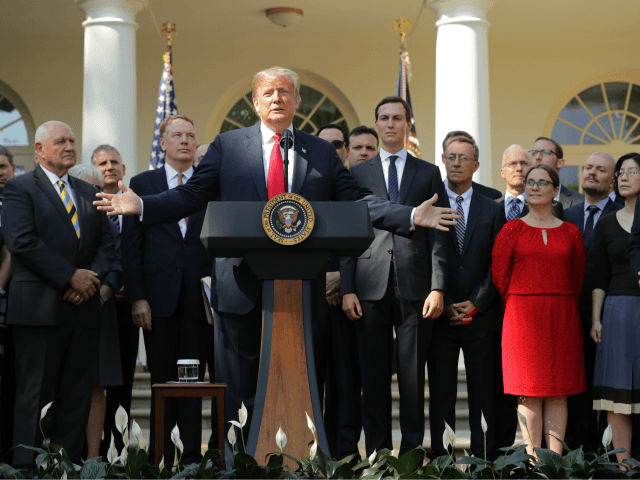While the Trump administration has touted the new trade pact with Mexico and Canada as a historic achievement and a promise kept, critics say that the differences between the NAFTA and the new agreement are so slight as to make the entire effort to renegotiate the trade pact “unnecessarily painful.”
“This is better than anything the United States has ever negotiated before,” U.S. Trade Representative Robert Lighthizer said. “It’s going to make a real difference for working men and women in this country. Now, some Wall Street guys are going to have to figure out another way to make a fortune, but in terms of working men and women, and farmers and ranchers it’s going to make a big difference.”
“After spending a year and a half alienating our friends, punishing our farmers and manufacturers with devastating tariffs and counter-tariffs, and fracturing the hard-won alliance we had built to isolate and pressure China, we finally got a new trade deal — and a “new” trade strategy,” Catherine Rampell of the Washington Post opined. “Yet somehow, they look an awful lot like the old ones.”
So who is right?
Let’s start with those who have the most to gain or lose here: American manufacturing workers and farmers. The deal has been hailed by the United Steelworkers as requiring significantly greater protection for workers than Nafta. The United Autoworkers described it as a “step in the right direction” but raised concerns that it might not be enforced rigorously enough.
“This is a big win for Wisconsin’s dairy farmers. This new deal will open up Canadian markets for our dairy farmers, eliminate certain tariffs, and eliminate Canada’s protectionist trade policies related to ultra-filtered milk that targeted Wisconsin dairy producers,” Wisconsin Governor Scott Watson said.
Across the border, Canadian dairy farmers say the deal is a “huge disappointment.” The leader of Canada’s social democrats complained “we have a new name, but a worse deal.”
“The Liberals made concession after concession, until the Trump administration got the deal it wanted,” said United Steel Workers Canadian Director Ken Newman.
So at least judging from the reactions of labor and farm leaders in the U.S. and Canada, the deal is a significant “win” for the Trump administration.
The are several significant changes in the USMCA that are likely responsible for this.
Rules of Origin
In order to qualify for duty-free treatment, so-called “rules of origin” look at what percent of a product is imported from elsewhere and what percent is made in North America. The new pact raises the North American content requirement for auto manufacturing from 62.5 percent to 75 percent. That is a large increase that diminishes the attractiveness of manufacturing outside of North America, in part because it makes it hard to obtain economies of scale with smaller inputs.
Sunset Clause
Nafta was forever. Unfortunately, the world is a dynamic place and over time the agreement became stale. But since it had no mechanism for automatic updates, it continued to fall further and further out of sync with economic realities. First and foremost, it was advertised as likely to shrink the U.S. trade deficit with Mexico but instead it greatly expanded it.
The USMCA will expire in 16 years. Every six years, the countries involved will meet to decide whether or not to extend it for another six years. This was a compromise between the Trump administration’s initial demand for an agreement set to expire after five years and the demands of Canada and Mexico that it last indefinitely.
Workers Rights
The new trade pact also guarantees Mexican workers the right to form and join unions. In the U.S., unions are skeptical that this will be properly enacted in Mexico and enforced going forward. But in theory, it would diminish the benefits to U.S. companies from moving south of border to be able to employ workers denied the right to organize.
Wages
The new deal also requires a minimum input for duty-free manufacturing from workers paid at least $16 an hour. The practical short term effect will be to shift production away from Mexico and towards Canada and the U.S., Over the long term, it could result in higher wages for Mexican workers, shrinking the wage differential that acts like a magnet pulling jobs south of the border. Sunset clause
Milk, Cheese, Ice cream
Oddly enough, this was one of the most contentious issues in the negotiations. Canada has a very complex system of barriers and subsidies that make it very difficult for U.S. dairy farmers to export their products. Canada is keeping this system in place but increasing the market share U.S. dairy products are permitted to compete for,
Intellectual Property
Here are some of the highlights of the new proptections for IP, as provided by the Trump administration.
- Include 10 years of data protection for biologic drugs and a robust scope of products eligible for protection.
- Require full national treatment for copyright and related rights so United States creators are not deprived of the same protections that domestic creators receive in a foreign market.
- Continue to provide strong patent protection for innovators by enshrining patentability standards and patent office best practices to ensure that United States innovators, including small- and medium-sized businesses, are able to protect their inventions with patents.
In short, it’s a much better agreement than NAFTA. Score this one as a win for the Trump administration, American workers, American farmers, and American innovators.

COMMENTS
Please let us know if you're having issues with commenting.